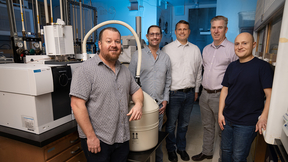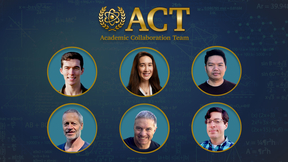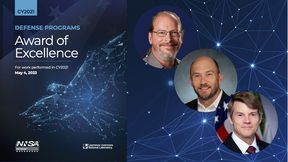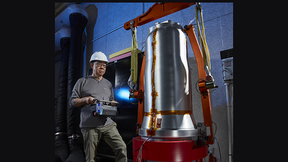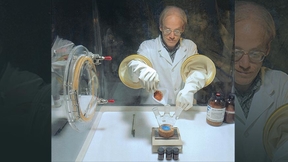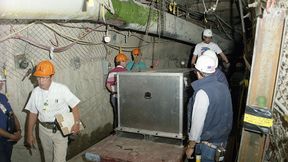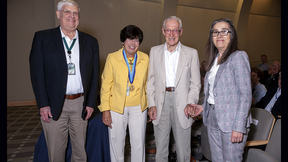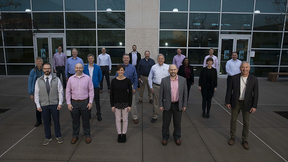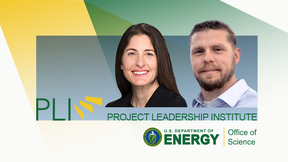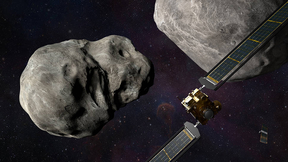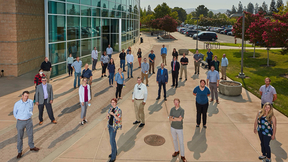Back
TATB (1,3,5-triamino-2,4,6-trinitrobenzene) is an important explosive compound because of its extensive use in munitions and world-wide weapons systems. Despite its importance, researchers have been trying to understand its response to temperature extremes for the past 50 years. A Lawrence Livermore National Laboratory (LLNL) team has uncovered a new thermal decomposition…
Six scientists at the Lawrence Livermore National Laboratory (LLNL) were recently granted awards through the Lab’s 2023 Academic Collaboration Team (ACT) annual call for proposals. Awards support university research partners for up to three years to perform research in collaboration with Lab scientists and offer an important way to build long-term connections with…
In the quest to understand how nuclear debris forms, a team of scientists at Lawrence Livermore National Laboratory (LLNL) has developed an approach to studying the oxidation mechanism of gas phase uranium in extreme environments. In research recently published in Scientific Reports, the team outlined their work, which combined experimental data from a plasma flow reactor …
Lawrence Livermore National Laboratory Director Kim Budil today announced that the 2023 John S. Foster, Jr. Medal is awarded to retired U.S. Navy Admiral Richard W. Mies. The eighth recipient of the prestigious Foster Award, Mies has served as a member of the LLNL Board of Governors since 2004 and is recognized for his exceptional and inspirational career dedicated to…
The Department of Energy’s National Nuclear Security Administration (NNSA) and the Department of Defense (DoD) recently approved the W87-1 Modification Program to enter Phase 6.3, Development Engineering, through the Nuclear Weapons Council. During this phase of the nuclear weapons lifecycle process, NNSA will continue to work closely with DoD to conduct experiments, tests…
In virtual ceremonies held May 4 and June 26, Marvin Adams, deputy administrator for Defense Programs at the National Nuclear Security Administration (NNSA), honored individuals and teams at Lawrence Livermore National Laboratory (LLNL) and partner sites for their outstanding contributions to nuclear security. The Defense Programs Awards of Excellence recognition events…
Lawrence Livermore National Laboratory (LLNL) and Sandia National Laboratories (Sandia) recently successfully executed the second joint abnormal thermal environment (ATE-2) test for the W80-4 Life Extension Program (LEP). Carried out at Sandia’s Cross Wind Test Facility in New Mexico, ATE-2 was a fast-heat, fully engulfing system-level fuel fire test, the first for LLNL in…
In March, the Department of Energy’s National Nuclear Security Administration's Deputy Administrator for Defense Programs approved the W80-4 Life Extension Program (LEP) to transition into Phase 6.4, Production Engineering. The W80-4 LEP achieved Phase 6.4 entry following successful execution of the Preliminary Design Review and Acceptance Group Review and the System…
Planetary defense physicist Megan Bruck Syal on Wednesday represented Lawrence Livermore National Laboratory (LLNL) at “Space STEM Task Force Pathways to the Federal Space Workforce,” an outreach event hosted by the National Science Foundation. Multiple federal government agencies came together in a virtual interactive session to provide information for students, early…
The first peer-reviewed results from NASA’s Double Asteroid Redirection Test (DART) mission were published Wednesday by Nature, including contributions from LLNL’s planetary defense team. The DART spacecraft executed a successful hypervelocity impact of 150-meter asteroid Dimorphos on Sept. 26, 2022. Analysis by Earth-based telescopes determined that the impact…
Physicist Tom Ramos has had several roles for the past 40 years at Lawrence Livermore National Laboratory. He served as a member of the nuclear team that developed the X-ray laser for President Reagan’s Strategic Defense Initiative, he supported United States arms control negotiations for START, and over a span of seventeen years he created and ran a program for the…
The last nuclear test, code-named Divider, took place 30 years ago, on Sept. 23, 1992. That year, President Bush declared a temporary moratorium on nuclear testing, which became permanent during the Clinton administration. This ending of the era of nuclear testing was also the beginning of stockpile stewardship. Leaders from the Department of Energy (DOE), and Lawrence…
The last nuclear test, code-named Divider, took place 30 years ago, on Sept. 23, 1992. That year, President Bush declared a temporary moratorium on nuclear testing, which became permanent in 1995, during the Clinton administration. This ending of the era of nuclear testing coincided with a Presidential announcement of the beginning of stockpile stewardship. As the decision…
The year was 1992. At 10 a.m. on a balmy September morning in the desolate Nevada desert, a countdown began. And for a few brief moments, the ground violently shook. In a NASA-esque control room at the Nevada Test Site (NTS), Lawrence Livermore National Laboratory (LLNL) engineer Jack Cutting watched as monitors and oscilloscopes began sending back data collected on the…
Department of Energy (DOE) Under Secretary for Nuclear Security Jill Hruby joined fellow luminaries in the national nuclear security community at Lawrence Livermore National Laboratory (LLNL) on Sept. 8 to honor Miriam “Mim” John, recipient of the 2022 John S. Foster, Jr. Medal. John, vice president emerita of Sandia National Laboratories, became the first woman awarded…
Justin Witkowski came to Lawrence Livermore National Laboratory (LLNL) for a unique internship opportunity, one that would allow him to gain some practical experience during the gap between completing his undergraduate degree and starting his military career in the Navy. Witkowski started his LLNL internship in February under the Academic Cooperation Program (ACP). ACP…
Lawrence Livermore National Laboratory (LLNL) and the Y-12 National Security Complex have teamed up to rapidly modernize legacy technology and production methods of crucial components for the U.S. nuclear deterrent. A leading example of this collaboration is the recent successful installation and testing of the electron beam cold hearth melter (EBCHM) – a machine that can…
The Department of Energy (DOE) Project Leadership Institute (PLI) has selected Lawrence Livermore National Laboratory’s Lara Leininger and Al Churby as 2022 cohort participants. Members of the PLI cohort have demonstrated their expertise as technical, business systems or project leaders, with significant experience and responsibility for project or organization performance…
Lawrence Livermore National Laboratory (LLNL) is taking part in NASA’s first-ever planetary defense test, which deliberately collides a spacecraft into an asteroid called Dimorphos. The Double Asteroid Redirection Test (DART) will examine technologies that will prevent an impact of Earth by a hazardous asteroid. DART is the first demonstration of the kinetic impactor…
The Post-Detonation Rapid Response Research Venture — also known as R-cubed or R3 — is combining basic research and development of emergent technologies, predictive capabilities and systems assessment to revolutionize the speed and flexibility of technical nuclear forensic (TNF) response to nuclear events. The venture is a multi-laboratory collaboration led by Lawrence…

